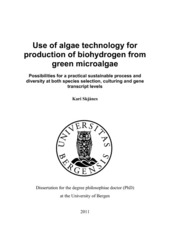| dc.contributor.author | Skjånes, Kari | eng |
| dc.date.accessioned | 2011-07-04T15:21:56Z | |
| dc.date.available | 2011-07-04T15:21:56Z | |
| dc.date.issued | 2011-01-28 | eng |
| dc.identifier.isbn | 978-82-308-1687-5 (print version) | en_US |
| dc.identifier.uri | http://hdl.handle.net/1956/4823 | |
| dc.description.abstract | Algae technology represents an extensive research field which has developed rapidly over the last decades. The research activities extend from algae cultivation including CO2 capture, production of commercial products such as health food, aquaculture and animal feed, production of valuable metabolites, to conversion of solar energy into energy carriers like biohydrogen or biodiesel. A combination of several aspects of algae technology into a multidisciplinary process is proposed in this work. Valuable metabolites produced by algae include for example carotenoids, unsaturated fatty acids, vitamins, glycerol, components with medical activities and a number of antioxidants. Many of these are secondary metabolites produced as a response to different forms of environmental stress, and they may function as protection mechanisms to avoid damage to the cells. Biohydrogen from green microalgae is an expanding field which has made great progress through the last decade. By exposing some species of algae to environmental stress, e.g. by depriving the algae of sulfur in light, it is possible to produce significant amounts of hydrogen gas. However, this technology is still in its infancy, and there is significant potential for technology development and improvement at every level. In this study, the possibility of producing hydrogen from solar energy by using green microalgae is explored at species selection-, culturing- and gene transcription levels. It is demonstrated that there is a considerable number of species currently known to have potential for hydrogen production, and the same is true for production of valuable metabolites. The effects of different stress reactions on production of the valuable components are described, along with the purpose of their production. This knowledge can be used to evaluate the possibilities for producing hydrogen and high value products efficiently in the same process. Hydrogen production under sulfur deprivation is explored in several species of green algae under controlled conditions, and Chlamydomonas noctigama shows the ability to produce hydrogen with efficiency comparable to the model organism Chlamydomonas reinhardtii. The ability to produce hydrogen under sulfur deprivation is also explored in relation to the different species’ ability to show heterotrophic or mixotrophic growth on acetate. A photobioreactor specifically designed for algae hydrogen production is described for lab scale research purposes, including considerations for measurement devices and materials choice. Hydrogen production by the algae C. noctigama is further explored at molecular level. By using RT-PCR followed by PCR with degenerate primers, mRNA with homology towards green algal hydrogenases was identified. The cDNA sequences were translated to putative amino acid sequences, and analyzed in respect to amino acids characteristic for green algal hydrogenases and amino acids which share characteristics with both hydrogenases and narf-like proteins. These results were used to evaluate the identification of the mRNA sequences found in C. noctigama. While other green algae have been shown to contain two different hydrogenases, it is here demonstrated that C. noctigama is able to transcribe three distinct genes which share essential characteristics with hydrogenases. The combination of these results provides valuable insights at several levels of a combined process for production of biohydrogen and other valuable products. Further studies of these topics may result in a sustainable process where solar energy can be converted into hydrogen in an integrated manner, where production efficiencies are sufficient for an economic exploitation of algal technology using algal stress reactions. | en_US |
| dc.language.iso | eng | eng |
| dc.publisher | The University of Bergen | en_US |
| dc.relation.haspart | Paper I: Biomolecular Engineering 24(4), Skjånes, K.; Lindblad, P.; Muller J., BioCO2 - a multidisciplinary, biological approach using solar energy to capture CO2 while producing H2 and high value products, pp. 405-413. Copyright 2007 Elsevier. Full-text not available in BORA due to publisher restrictions. The published version is available at: <a href="http://dx.doi.org/10.1016/j.bioeng.2007.06.002" target="blank"> http://dx.doi.org/10.1016/j.bioeng.2007.06.002</a> | en_US |
| dc.relation.haspart | Paper II: Skjånes, K. & Lindblad, P. (2010). Analysis of the potential for green microalgae to produce hydrogen, pharmaceuticals and other high value products in a combined process. Draft version. Full-text not available in BORA. | en_US |
| dc.relation.haspart | Paper III: International Journal of Hydrogen Energy 33(2), Skjånes, K.; Knutsen, G.; Källqvist, T.; Lindblad, P., H2 production from marine and freshwater species of green algae during sulphur deprivation and considerations for bioreactor design, pp. 511-521. Copyright 2008 Elsevier. Full-text not available in BORA due to publisher restrictions. The published version is available at: <a href="http://dx.doi.org/10.1016/j.ijhydene.2007.09.040" target="blank"> http://dx.doi.org/10.1016/j.ijhydene.2007.09.040</a> | en_US |
| dc.relation.haspart | Paper IV: International Journal of Hydrogen Energy 35(3), Skjånes, K.; Pinto, F. L.; Lindblad, P. Evidence for transcription of three genes with characteristics of hydrogenases in the green alga Chlamydomonas noctigama, pp. 1074-1088. Copyright 2010 Elsevier. Full-text not available in BORA due to publisher restrictions. The published version is available at: <a href="http://dx.doi.org/10.1016/j.ijhydene.2009.10.091" target="blank"> http://dx.doi.org/10.1016/j.ijhydene.2009.10.091</a> | en_US |
| dc.title | Use of algae technology for production of biohydrogen from green microalgae: Possibilities for a practical sustainable process and diversity at both species selection, culturing and gene transcript levels | en_US |
| dc.type | Doctoral thesis | |
| dc.rights.holder | The author | en_US |
| dc.rights.holder | Copyright the author. All rights reserved | en_US |
| dc.subject.nsi | VDP::Mathematics and natural science: 400::Zoology and botany: 480::Marine biology: 497 | en_US |
